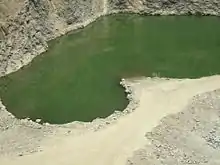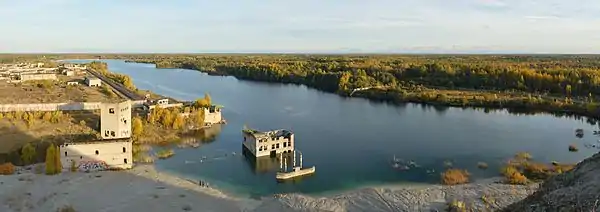Quarry lake
A quarry lake is a lake that is formed after a quarry has been dug through a mining operation.

Formation
During the mining process, water must be emptied. But after the mining operation has been abandoned, groundwater is allowed to seep in, and rainwater collects in the quarry. The depth of a quarry lake is dependent upon rainfall in the region.[1]
Hazards to Humans
Water-filled quarries can be very deep, often 50 ft (15 m) or more, and surprisingly cold, so swimming in quarry lakes is generally not recommended. Unexpectedly cold water can cause a swimmer's muscles to suddenly weaken; it can also cause shock and even hypothermia.[2] Though quarry water is often very clear, submerged quarry stones and abandoned equipment make diving into these quarries extremely dangerous. Several people drown in quarries each year.[3][4]
Ecology
Quarry lakes, even lakes within active quarries, can provide important habitats for animals.[5]
References
- Chang, Ni-Bin. Effects of Urbanization on Groundwater: An Engineering Case-Based Approach ... pp. 33–34. Retrieved May 31, 2012.
- "American Canoe Association explanation of cold shock". Enter.net. Archived from the original on 2012-06-16. Retrieved 2012-05-14.
- "US Dept. of Labor list of mine related fatalities". Msha.gov. Archived from the original on 2012-03-09. Retrieved 2012-05-14.
- "on quarry drownings". Geology.com. 2007-11-03. Retrieved 2012-05-14.
- Sievers, Michael (19 May 2017). "Sand quarry wetlands provide high-quality habitat for native amphibians". Web Ecology. 17 (1): 19–27. doi:10.5194/we-17-19-2017.

